 |
Mendi + Keith Obadike: American Cypher (installation view)
Photo: Adam Reich |
I always intend to write up arts-related events that I attend, but before I know it a certain summer languor--which during the school year transforms into teaching and grading responsibilities--overwhelms me, and before I know it, not just days, but weeks have passed. Here retrospectively then are some paragraphs, brief, and photographs from two recent events.
Two Sundays ago I dropped by the Studio Museum in Harlem to catch intermedia artists Mendi + Keith Obadike conversing with Abbe Schriber about their current exhibit there, American Cypher, which is up until June 30, 2013 (next week if you're in town), as well as about their collaborative projects and practice, and a host of other topics related to both. I arrived not long after the event began, so I missed the pop quiz they distributed, but I did get to hear curatorial assistant Schriber, the show's organizer, pose a number of questions about their fascinating exhibit, which explores DNA coding, race, digital aesthetics, and the complexities surrounding our popular understandings of genetics and history.
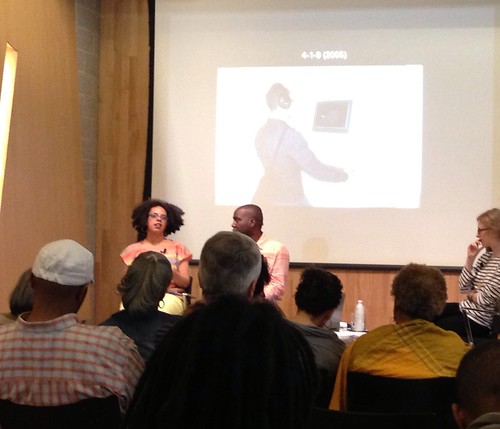 |
| Mendi + Keith in conversation with Abbe Schriber |
|
The duo walked the audience through
American Cypher's structure and format, which respond to American stories about race, history, DNA, and the law, and comprises a eight-channel sound installation with video, a series of prints, and a book, and which is one version of a multiformat suite of works that
include scores produced at the invitation of
Rhizome,
prints, a letterpress book, and
a public sound art installation at
Bucknell University.
The Griot Institute for Africana Studies and
Bucknell's Samek Art Gallery originally commissioned the works, in which Mendi + Keith explore five stories about Black Americans (or, in the case of one person, a racist self-identified "White" person with African ancestry) that, as their Vimeo writeup says, "hinges on deciphering the genetic code."
The five stories include explorations of the genetic codes of
James Watson, the Nobel Laureate (and racist) noted above; US President
Barack Obama;
Oprah Winfrey, whose "dream ancestry" of being a
Zulu DNA evidence undermined (she has West African "Mende" origins, I believe); two men caught in the net of the
US penal system; and at the center of the project
Sally Hemings, the enslaved young woman who bore several children by US President
Thomas Jefferson, a well-known story that DNA evidence in 1998 helped to verify (tying Hemings's descendants to the Jefferson family).
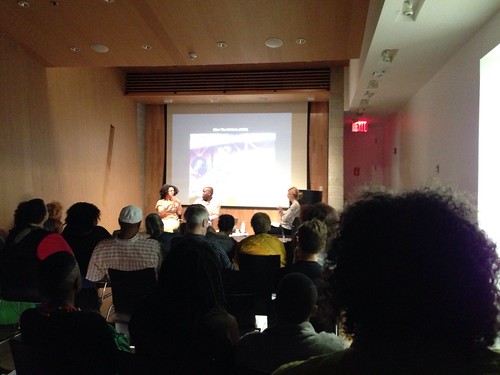 |
| Mendi + Keith in conversation with Abbe Schriber |
Mendi + Keith made original recordings of Hemings' last surviving possession, a small bell, on display at
Monticello, Jefferson's historic estate in
Charlottesville, that
Martha Jefferson, Thomas Jefferson's late wife and Hemings's half-sister) gave to her. A clip of Keith handling the bell and the recording it played during the conversation, and they later digitally altered the tracks, while also using the genetic code of the Hemings and Jefferson family lines to create the soundscape playing at the Studio Museum. They, like the exhibit, are highly informative and entertaining, wearing their brilliance quite lightly, but the profound implications of their work in this and other projects, and of the ideas they're exploring, are serious and continue to play in my mind.
from
Keith Obadike on
Vimeo.
***
Last week, I headed back up to Harlem to see my dear friend (and sister!)
Tisa Bryant give a presentation, which included a conversation with archivist, publisher and author
Steven Fullwood, to the
Ordinary People Book Series on her first book,
Unexplained Presence, a highly innovative and thought-changing collection of essays and imaginative texts that attempt to understand and think through
the unexplained presence of various Black figures in works of European literature and film. Whether exploring the severed black head in
Virginia Woolf's
Orlando (1928) or the frequently undiscussed irruptions of colonial critique in
Michelangelo Antonioni's
L'eclisse (1962) or the uncredited but absolutely central and vital performance of
Zakes Mokae in
John Schlesinger's
Darling (1965), Tisa provides a way of seeing what is right before our eyes but nevertheless, under the perspective of one set of gazes, passed over often in silence.
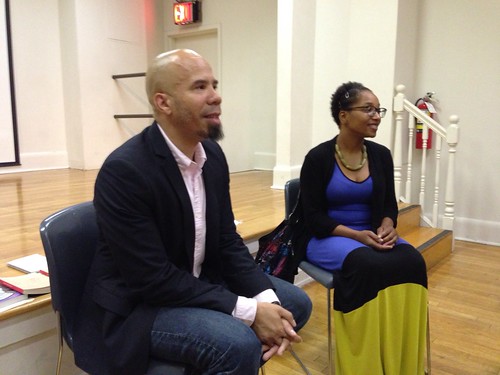 |
| Steven and Tisa |
Although I have read and discussed this book many times, including with students, I never fully knew the process by which Tisa drafted it, so the conversation illuminated this and a number of other points, such as what happened to the
novel that this project had originally been. (She is, she mentioned, still thinking about and working on it, among her other projects.) I also had never seen Tisa talk about the book in conjunction with film clips, which she did to great effect, showing clips of
Darling and
François Ozon's
Eight Women (2002), which is both an homage to
George Cukor's iconic 1939 film
The Women, but also a strange and enthralling cinematic experience in itself. Tisa walked the audience through the film's disturbing but utterly important treatment, from the film's opening frames, of the black maid, Madame Chanel, played by
Firmine Richard, who is literally pushed to the floor by one of the film's villains, her now no-longer secret lover, played by
Fanny Ardant. I won't give away the film or Tisa's essay, but I will say that Tisa's discussion enriched my understanding both of her project and the film.
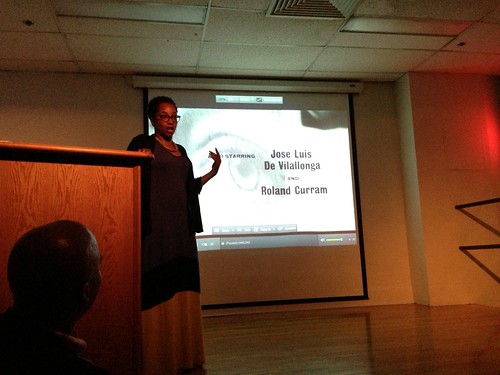 |
| Tisa discussing Darling |
I'll conclude by noting how enjoyable the event was, particularly in its informality, and in Steven's questions and his encouragement of the audience to ask questions. A number of writers and filmmakers were in the audience, so they came informed, and Tisa handled the queries with aplomb. If you haven't read the book, do order a copy and check out what she's up to.
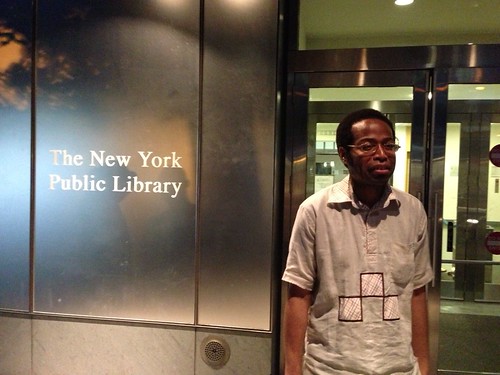 |
Photographer Donald Agarrat, who
took photos during the event |
 |
| Shelagh Patterson, Erica Doyle, and Tisa |
















No comments:
Post a Comment